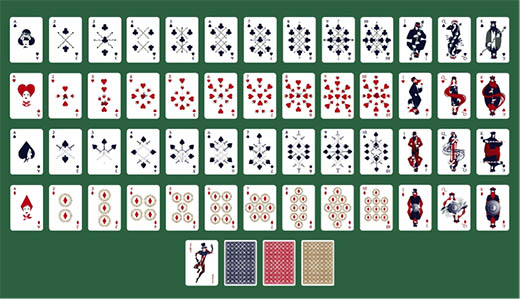
|
| « Articles | History of Playing Cards | Gallery of Playing Cards | Card Games Rules | CONTACT |
How decks of cards differ across Europe

Many games use playing cards, and the chances are, you've got a deck or two lying around at home. A lot of casino games use decks of cards, with Blackjack and Poker two prime examples. But you'll also find card games on your electronic devices, like Solitaire or Freecell. Did you know that before playing cards evolved into what we know and love today, there were many variations? Playing cards have a rich history and many geographical influences have shaped their path. Here, we take a look at some of the differences between decks of cards throughout Europe.
Spain
Spain was one of the first countries in western culture to utilise playing cards, which derived from the Mamluk Egypt deck. Like a modern-day 'standardised' deck, the Spanish set utilises four suits, but the packs consist of 40 or 48 cards, as opposed to the 52 we are familiar with.
As fans of Spanish Blackjack will know, the decks omit the 10s of each suit, so have the ranks 1-9, as well as three different picture cards (ranked 10-12). The three face cards rank in a similar way to a standardised deck but comprise of a Jack (or Sota), Knight (Caballo, meaning horse) and King (Rey).
Spanish 'stripped' decks are also available, which omit the 8s, 9s, and jokers. This specific set of cards is used to play the traditional game of Ombre, popularised in the 17th century. The suits are the same as the ones found on Italian cards, and these both resemble the Arab decks. The four suits are: clubs, coins, cups, and swords.
Germany
Many Central European countries still use German playing cards today. While they started off like Latin-suited decks, this changed in the mid-1400s. The main difference is the suits used and in German playing cards, these are: acorns (Eichel), leaves (Blatt), hearts (Herz), and bells (Schelle).
The decks also comprise fewer cards than Spanish decks, and northern and southern Germany both have different packs. The northern sets consist of 32 cards: an Ace, number cards ranking 7-10, and three face cards (Under Knave, Over Knave, and King). Southern decks have an extra four cards, utilising the 6s of each suit.
France
It is the French deck that we are most familiar with, which was first established in the 15th century. It was the French that developed the four suits we appreciate today: clubs, diamonds, hearts, and spades. Of course, they have native titles: trefles, carreaux, couers, and piques. The French are also credited with dividing the four suits into two colours: red and black.
One of the most distinguishing features of a French deck of cards is the addition of the Queen within the face cards. As we've mentioned above, Latin and German playing cards feature three male face cards, derived from the original Mamluk cards. The Queen first appeared in Italian tarot cards, and it was something that the French adopted. They replaced the Knight with it as the middle-ranking face card.
The next time you're playing a card game, why not take a closer look at the cards you're playing with. Is there anything unique or different about them?
|
|
|
|